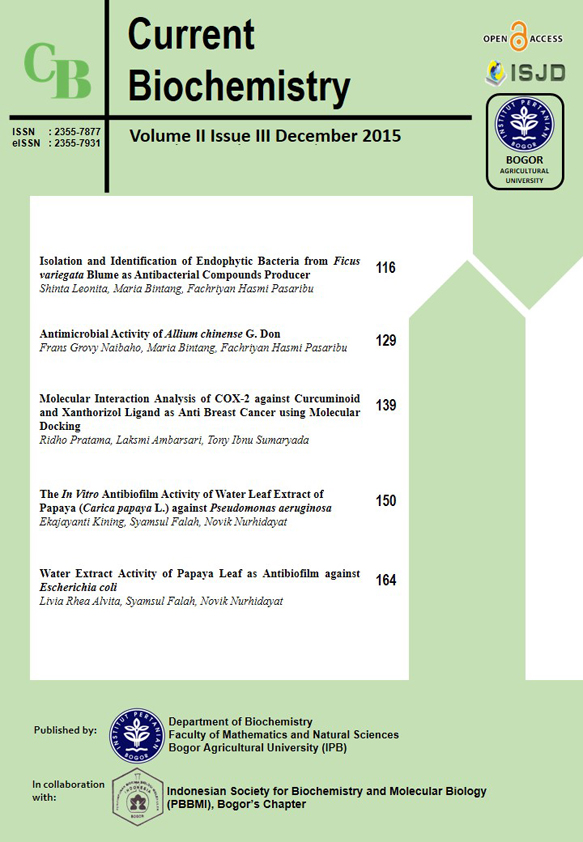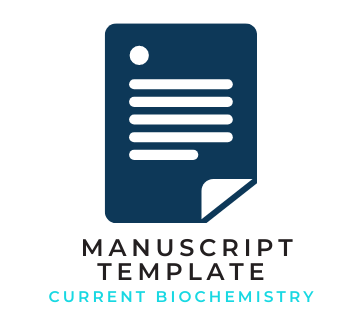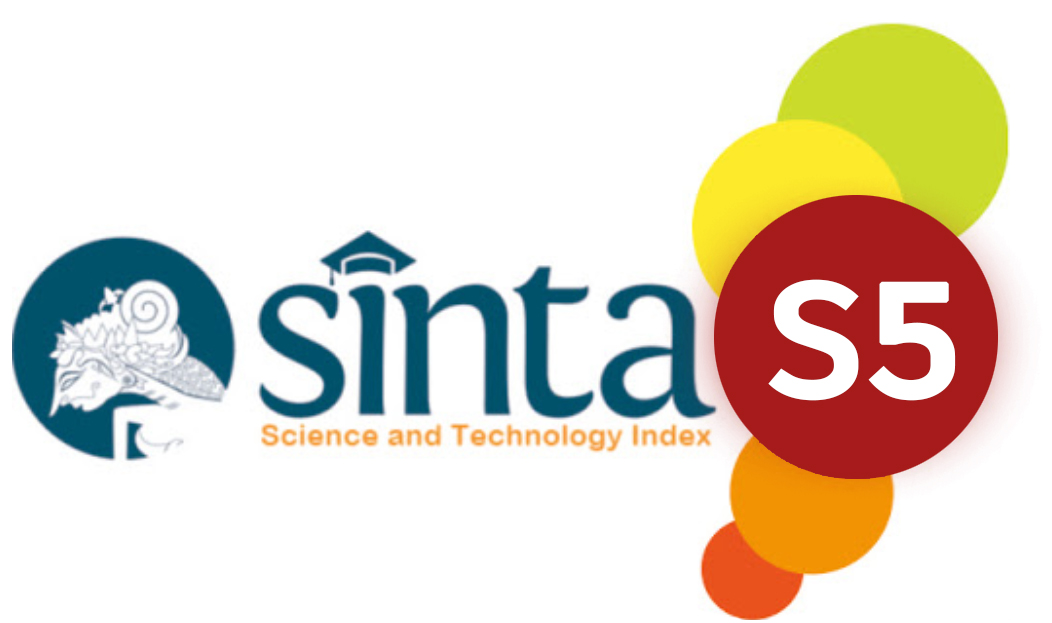Water Extract Activity of Papaya Leaf as Antibiofilm against <i>Escherichia coli</i>
Abstract
Biofilms are significant hazards in the food industry. The presence of Escherichia coli biofilms in food industry is potentially causing food spoilage that will shorten the shelf life as well as lead to the spread of disease through food. The purpose of this study is to determine the phytochemical compound of aqueous extract of papaya leaves and to determine its activity on inhibition of cell attachment and growth, and on degradation of the biofilm using Micro-titter Plate Biofilm Assay. The results phytochemical test showed that papaya leave extract contains alkaloid, tanin, flavonoid, and steroid and have anti-biofilm activity. Papaya leave extract with highest activity caused biofilm degradation of 48,99%. The optimum temperature of biofilm degradation (>52,5%) by papaya leaves extract was around 35oC - 40oC. The optimum contact time and extract concentration were 57-60 minutes and 75-100%, respectively.
References
Akiyama H, Fuji K, Yamasaki O, Oono T, Iwatsuki K. 2001. Antibacterial action of several tanins against Staphylococcus aurens. J Antimicrob Chemother. 48 : 487-491.
Arumugam N, Boobalan T, Rajeswari PR, Duraimurugan MD. 2014. Antimicrobial activity and phytochemical screening of Cynodon dactylon and Carica papaya. RIB. 5(5): 21-31.
Chen J, Rossman ML, Pawar DM. 2007. Attachment of enterohemorragic Escherichia coli to the surface of beef and a culture medium. LWT–Food Science and Technology. 40: 249–254.
Chmielewski RAN & Frank JF. 2003. Biofilm formation and control in food processing facilities. CRFSFS. 2, 22-32.
Cobrado L, Azevedo MM, Silva A. 2012. Cerium, chitosan and hamamelitannin as novel biofilm inhibitors. J Antimicrob Chemother. 67, 1159-1162.
Donlan RM. 2002. Biofilms: Microbial life on surface. Emerging Infectious Diseases. 8 : 881890.
Gomashe AV, Sharma AA, Kasulkar A. 2014. Investigation of biofilm inhibition activity and antibacterial activity of Psidium guajava plant extracts against Streptococcus mutans causing dental plaque. Int J Microbiol AppSci. 3 (9) 335-35.
Harborne JB. 1998. Phytochemical Methods A Guideto Modern Techniques of Plant Analysis. London. Chapman & Hall.
Houdt RV & Michiels CW. 2010. Biofilm formation and the food industry, a focus on the bacterial outer surface (Review article). J Appl Microbiol. ISSN 1364-5072.
Karatan E & Watnick P. 2009. Signals, regulatory networks, and materials that build and break bacterial biofilms. Microbiol Mol Biol Rev. 73, 310–347.
Lee JH, Park JH, Cho HS, Joo SW, Cho MH, Lee J. 2013. Antibiofilm activities of quercetin and tannic acid against Staphylococcus aureus. Biofouling. 29; 5.
Lee JH, Regmi SC, Kim JA, Cho MH, Yun H, Lee CS, Lee J. 2011. Apple flavonoid phloretin inhibits Escherichia coli O157:H7 biofilm formation and ameliorates colon inflammation in rats. Infect Immun. 79:4819-27.
Lund BM, Baird-Parker TC, Gould GW. 2000. The microbiological safety and quality of food. Gaithersburg (US). Aspen Publishers Inc.
Montgomery C. 2008. Design and Analysis of Experiments: 7th edition. Singapura (AU): Wiley and Sons Inc.
Moussaoui E, Nijs M, Paul C, Wintjens R, Vincentelli J, Azarkan M, Looze Y. 2001. Revisiting the enzymes stored in the laticifers of Carica papaya in the context of their possible participation in the plant defence mechanism. CMLS. 58: 556-570.
Nitisapto M & Siradz SA. 2005. Evaluasi kesesuaian lahan untuk pengembangan jahe pada beberapa daerah di Jawa Tengah dan Jawa Timur. JITL. 5(2): 15-19.
Park J, Kaufmann GF, Bowen JP, Arbiser JL, Janda KD. 2008. Solenopsin A, a venom alkaloid from the fire ant Solenopsis invicta, inhibits quorum-sensing signaling in Pseudomonas aeruginosa. J Infect Dis. 198, 1198- 1201.
Prasasti D dan Hertiani T. 2010. Potensi Campuran Minyak Atsiri Rimpang Temulawak dan Daun Cengkeh sebagai Inhibitor Plak Gigi. J Indones Medical Plant. 3 (2).
Rohde H, Frankenberger S, Zahringer U, Mack D. 2010. Structure, function and contribution of polysaccharide intercellular adhesin (PIA) to Staphylococcus epidermidis biofilm formation and pathogenesis of Biomaterial Associated Infections. Eur J Cell Bio. 89; 1.
Sandasi M, Leoonard CM, Viljoen AM. 2010. The in vitro antibiofilm activity of selected culinary herbs and medical plants against Listeria monocytogenes. LAM. (50) 30-35.
Stoodly P, Sauer K, Davies DG,Costertoo JW. 2002. Biofilm as complex differentiated communities. Annu Rev Microbial. 56: 187-209.
Sutherland IW. 2001. The biofilm matrix—An immobilized but dynamic microbial environment. Trends Microbiol. 9, 222-227.
Tarver T. 2009. Biofilms a thread to food safety. food technology. pp: 46-52 Available at: http://www.ift.org (05 Desember 2014)
Vikram A, Jayaprakasha GK, Jesudhasan PR, Pillai SD, Patil BS. 2010. Suppression of bacterial cell–cell signalling, biofilm formation and type III secretion system by citrus flavonoids. J Microbiol. 109:515–27.
Wuryanti 2004. Isolasi dan Penentuan Aktivitas Spesifik Enzim Bromelin dari Buah Nanas (Ananas comosus L.). Artikel: JKSA. Vol VII No. 3: 83-87.










